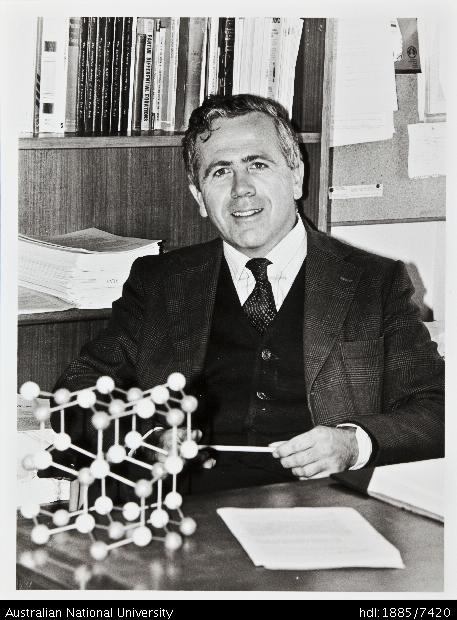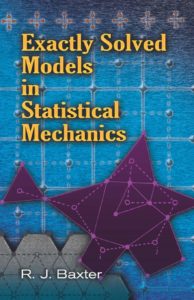
This post is about a model of statistical physics which consists in a probability measure on \( {\mathbb{R}^n} \) modeling \( {n} \) one-dimensional unit charge particles subject to Coulomb pair repulsion and to attraction with respect to a background of opposite charge. It is a one-dimensional Coulomb gas (not a log-gas!) confined by the potential generated by a charged background, a special case of the jellium model of Paul Eugene Wigner (1938). In the case of a uniform background, it is related to a conditioned Gaussian distribution. It was already observed by Rodney James Baxter (1963) that this model is exactly solvable. This exact solvability can be seen as the one-dimensional analogue of the exact solvability discovered by Eric Kostlan (1992) in the case of the two-dimensional Coulomb gas describing the spectrum of Ginibre random matrices.
One-dimensional Wigner jellium or Coulomb gas. The electrostatic potential at point \( {x\in\mathbb{R}} \) generated by a one-dimensional unit charge located at the origin is given by \( {g(x)=-|x|} \). By the principle of superposition, the electrostatic potential generated at point \( {x\in\mathbb{R}} \) by a distribution of charges \( {\mu} \) on \( {\mathbb{R}} \) is given by
\[ U_{\mu}(x)=(g*\mu)(x)=-\int|x-y|\mu(\mathrm{d}y) \]
and the electric field by \( {E_\mu=-U_{\mu}'=-g'*\mu=\mathrm{sign}*\mu} \). The derivative of \( {g} \) is the sense of distributions is the Heaviside step function \( {g'=\mathbf{1}_{-(\infty,0)}-\mathbf{1}_{(0,+\infty)}} \), which is an element of \( {\mathrm{L}^\infty} \) defined almost everywhere, while the second derivative of \( {g} \) in the sense of Schwartz distributions is a Dirac mass at zero \( {g''=-2\delta_0} \). It particular \( {g} \) is the fundamental solution of the Poisson equation and we can recover \( {\mu} \) from its potential by
\[ U''_{\mu}=g''*\mu=-2\delta_0*\mu=-2\mu. \]
The self-interaction energy of the distribution of charges \( {\mu} \) is
\[ \mathcal{E}(\mu) =\frac{1}{2}\iint g(x-y)\mu(\mathrm{d}x)\mu(\mathrm{d}y) =\int U_\mu\mathrm{d}\mu. \]
Let us consider now \( {n\geq1} \) one-dimensional unit charges at positions \( {x_1,\ldots,x_n} \), lying in a positive background of total charge \( {\alpha>0} \) smeared according to a probability measure \( {\rho} \) on \( {\mathbb{R}} \) with finite Coulomb energy \( {\mathcal{E}(\rho)} \). The total potential energy of the system is
\[ H_n(x_1,\ldots,x_n) = -\sum_{i<j} |x_i-x_j| -\alpha\sum_{i=1}^nU_{\rho}(x_i) \]
up to the additive constant \( {\alpha^2\mathcal{E}(\rho)} \). The system is charge neutral when \( {\alpha=n} \). Following Wigner (1938), let us define now the Boltzmann-Gibbs probability measure \( {P_n} \) over all the possible configurations at inverse temperature \( {\beta>0} \) by
\[ \mathrm{d}P_n(x_1,\ldots,x_n) =\frac{\mathrm{e}^{-\beta H_n(x_1,\ldots,x_n)}}{Z_n} \mathrm{d}x_1\cdots\mathrm{d}x_n \]
where
\[ Z_n=\int_{\mathbb{R}^n}\mathrm{e}^{-\beta H_n(x_1,\ldots,x_n)} \mathrm{d}x_1\cdots\mathrm{d}x_n. \]
It can be checked that \( {Z_n<\infty} \) if and only if \( {\alpha<n} \). Note that \( {P_n} \) is a one-dimensional Coulomb gas with external field associated to the potential \( {V=-\frac{\alpha}{n}U_\rho} \).
Baxter exact solvability for uniform backgrounds. The model is exactly solvable. Indeed, following Baxter (1963), we have the combinatorial identity
\[ -\sum_{i < j} |x_i - x_j| =\sum_{i<j}(x_{(j)}-x_{(i)}) =\sum_{k=1}^n (2k-n-1) x_{(k)}, \]
where \( {x_{(n)}\leq\cdots\leq x_{(1)}} \) is the reordering of \( {x_1,\ldots,x_n} \); in particular,
\[ x_{(n)}=\min_{1\leq i\leq n}x_i \quad\text{and}\quad x_{(1)}=\max_{1\leq i\leq n}x_i, \]
which allows to rewrite the potential energy as
\[ H_n(x_1,\dots,x_n) = \sum_{k=1}^n \Bigr((2k-n-1)x_{(k)}-\alpha_n U_\rho(x_{(k)})\Bigr). \]
We assume now that \( {\rho} \) is the uniform law on an interval \( {[a,b]} \). Then, for all \( {x\in\mathbb{R}} \),
\[ -U_\rho(x) =\frac{1}{b-a}\int_a^b|x-y|\mathrm{d}y =\begin{cases} \displaystyle\left|x-\frac{a+b}{2}\right| &\mbox{if }x\not\in[a,b]\\ \displaystyle\frac{\left(x-\frac{a+b}{2}\right)^2+\frac{(b-a)^2}{4}}{b-a} &\mbox{if }x\in[a,b] \end{cases}. \]
The potential \( {V=-\frac{\alpha}{n}U_\rho} \) then behaves quadratically on \( {[a,b]} \) and is affine outside \( {[a,b]} \). Conditioned on all the particles lying inside \( {[a,b]} \), it is possible to interpret \( {P_n} \) as a conditioned Gaussian law. Indeed, using Baxter's identity, if \( {\{x_1,\ldots,x_n\}\subset[a,b]} \) then
\[ H_n(x_1,\ldots,x_n) = \sum_{k=1}^n(2k-n-1)x_{(k)} +\frac{\alpha}{b-a}\sum_{i=1}^n\Bigr(x_{(i)}-\frac{a+b}{2}\Bigr)^2+\frac{n\alpha(b-a)}{4}. \]
This formula shows then that \( {X_n\sim P_n} \) is conditionally Gaussian in the sense that
\[ \mathrm{Law}\Bigr((X_{(n)},\ldots,X_{(1)})\bigm\vert \{X_1,\ldots,X_n\}\subset[a,b]\Bigr) \]
\[ \qquad =\mathrm{Law}\Bigr((Y_n,\ldots,Y_1)\bigm\vert a\leq Y_n\leq\cdots\leq Y_1\leq b\Bigr) \]
where \( {Y_1,\ldots,Y_n} \) are independent real Gaussian random variables with
\[ \mathbb{E}Y_k=\frac{a+b}{2}+\frac{b-a}{2\alpha}\left(n+1-2k \right) \quad\text{and}\quad \mathbb{E}((Y_k-\mathbb{E}Y_k)^2)=\frac{b-a}{2\alpha\beta}. \]
This was already observed by Baxter. Now if we consider the limit \( {a\rightarrow-\infty, b\rightarrow \infty} \) with \( {\alpha/(b-a) \rightarrow c > 0} \), then \( {P_n} \) can be interpreted as a Coulomb gas for which the potential is quadratic everywhere, namely \( {V=\frac{c}{2n}\left|\cdot\right|^2} \). This can also be seen as a jellium with a background equal to a multiple of Lebesgue measure on the whole of \( {\mathbb{R}} \). Under the scaling \( {x_i=\sqrt{n}y_i} \), this limiting case matches the model studied by Abhishek Dhar, Anupam Kundu, Satya N. Majumdar, Sanjib Sabhapandit, and Grégory Schehr (2018). This Coulomb gas model with quadratic external field in one dimension is analogous to the complex Ginibre ensemble which is a Coulomb gas in two dimensions.
Scale invariance. The model \( {P_n} \) has a scale invariance which comes from the homogeneity of the one-dimensional Coulomb kernel \( {g} \). Indeed, if \( {\mathrm{dil}_\sigma(\mu)} \) denotes the law of the random vector \( {\sigma X} \) when \( {X_n\sim\mu} \), then, for all \( {\sigma>0} \), dropping the \( {n} \) subscript,
\[ \mathrm{dil}_\sigma(P^{\alpha,\beta,\rho}) =P^{\alpha,\frac{\beta}{\sigma},\mathrm{dil}_\sigma(\rho)}. \]
In other words, if \( {X_n\sim P^{\alpha,\beta,\rho}} \) then
\[ \sigma X_n\sim P^{\alpha,\frac{\beta}{\sigma},\mathrm{dil}_\sigma(\rho)}. \]
This property is useful in the asymptotic analysis of the model as \( {n\rightarrow\infty} \), and reveals the special role played by \( {\alpha} \) as a shape parameter. Here the inverse temperature \( {\beta} \) is a scale parameter, in contrast with the situation for log-gases.
Asymptotic analysis. An asymptotic analysis of \( {P_n} \) as \( {n\rightarrow\infty} \) is conducted in a joint work arXiv:2012.04633 with David García-Zelada and Paul Jung, for general backgrounds. This is a continuation of our previous work devoted to two-dimensional jelliums. We study one-dimensional Wigner jelliums, not necessarily charge neutral, for which the unit charges are allowed to exist beyond the support of the background. The model can be seen as a one-dimensional Coulomb gas (not a log-gas!) in which the external field is generated by a smeared background on an interval. We first observe that the system exists iff the total background charge is greater than the number of unit charges minus one. Moreover we obtain a Rényi-type probabilistic representation for the order statistics of the particle system beyond the support of the background. Furthermore, for various backgrounds, we show convergence to point processes, at the edge of the support of the background. In particular, this provides asymptotic analysis of the fluctuations of the right-most particle. Our analysis reveals that these fluctuations are not universal, in the sense that depending on the background, the tails range anywhere from exponential to Gaussian-like behavior, including for instance Tracy-Widom-like behavior.
One Dimensional Models. Excerpt from Baxter's book on exactly solved models (1982):
"One-dimensional models can be solved if they have finite-range, decaying exponential, or Coulomb interactions. As guides to critical phenomena, such models with short-range two-particle forces (including exponentially decaying forces) have a serious disadvantage: they do not have a phase transition at a non-zero temperature (van Hove, 1950; Lieb and Mattis, 1966). The Coulomb systems also do not have a phase transition, (Lenard, 1961; Baxter, 1963, 1964 and 1965), though the one-dimensional electron gas has long-range order at all temperatures (Kunz, 1974).
Of the one-dimensional models, only the nearest-neighbour Ising model (Ising, 1925; Kramers and Wannier, 1941) will be considered in this book. It provides a simple introduction to the transfer matrix technique that will be used for the more difficult two-dimensional models. Although it does not have a phase transition for non-zero temperature, the correlation length does become infinite at H = T = 0, so in a sense this is a 'critical point' and the scaling hypothesis can be tested near it.
A one-dimensional system can have a phase transition if the interactions involve infinitely many particles, as in the cluster interaction model (Fisher and Felderhof, 1970; Fisher, 1972). It can also have a phase transition if the interactions become infinitely long-ranged, but then the system really belongs to the following class of 'infinite-dimensional' models.".
